-
PDF
- Split View
-
Views
-
Cite
Cite
Uddipan Banik, Frank C van den Bosch, Michael Tremmel, Anupreeta More, Giulia Despali, Surhud More, Simona Vegetti, John P McKean, Constraining the mass density of free-floating black holes using razor-thin lensing arcs, Monthly Notices of the Royal Astronomical Society, Volume 483, Issue 2, February 2019, Pages 1558–1573, https://doi.org/10.1093/mnras/sty3267
Close - Share Icon Share
ABSTRACT
Strong lensing of active galactic nuclei in the radio can result in razor-thin arcs, with a thickness of less than a milliarcsecond, if observed at the resolution achievable with very long baseline interferometry (VLBI). Such razor-thin arcs provide a unique window on the coarseness of the matter distribution between source and observer. In this paper, we investigate to what extent such razor-thin arcs can constrain the number density and mass function of ‘free-floating’ black holes, defined as black holes that do not, or no longer, reside at the centre of a galaxy. These can be either primordial in origin or arise as by-products of the evolution of supermassive black holes in galactic nuclei. When sufficiently close to the line of sight, free-floating black holes cause kink-like distortions in the arcs, which are detectable by eye in the VLBI images as long as the black hole mass exceeds ∼1000 Solar masses. Using a crude estimate for the detectability of such distortions, we analytically compute constraints on the matter density of free-floating black holes resulting from null-detections of distortions along a realistic, fiducial arc, and find them to be comparable to those from quasar milli-lensing. We also use predictions from a large hydrodynamical simulation for the demographics of free-floating black holes that are not primordial in origin and show that their predicted mass density is roughly four orders of magnitude below the constraints achievable with a single razor-thin arc.
1 INTRODUCTION
Strong gravitational lensing is a powerful tool to probe the distribution of matter in our Universe on a variety of scales and across a large range in redshift (e.g. Schneider, Ehlers & Falco 1992; Treu 2010). Particularly powerful is the notion that strong gravitational lensing can be used to probe the coarseness of the matter distribution along the line of sight by looking for distortions of arcs, arclets, rings, or multiply imaged sources arising from the strong gravitational lensing of some source due to a much more massive object. These distortions come in the form of flux-ratio anomalies (e.g. Mao & Schneider 1998; Dalal & Kochanek 2002; Mao et al. 2004; Metcalf 2005), modified time-delays (also known as the Shapiro delay, Keeton & Moustakas 2009; Mohammed, Saha & Liesenborgs 2015), or distortions in extended arcs (e.g. Koopmans 2005; More et al. 2009; Vegetti & Koopmans 2009; Vegetti et al. 2010, 2012; Hezaveh et al. 2016b; Birrer, Amara & Refregier 2017).
A particularly exciting development has been the use of image distortions to probe the abundance of dark matter (sub)haloes on subgalactic scales, which holds the potential to shed light on the nature of dark matter (e.g. Li et al. 2016, 2017; Hezaveh et al. 2016a; Bayer et al. 2018; Despali et al. 2018; Vegetti et al. 2018). In general, detecting lower mass haloes requires higher sensitivity, which in turn implies higher spatial resolution, or more small-scale structure in the source. Hence, one ideally wants to use arcs and Einstein rings that have been observed at the highest possible resolution. Over the last few years, state-of-the-art observations at radio and submillimetre wavelengths, with very long baseline interferometry (VLBI) and with the long baselines of the Atacama Large (sub)Millimetre Array (ALMA), respectively, have revealed a number of extremely thin lensing arcs, with a thickness of around 2–25 mas (e.g. ALMA Partnership et al. 2015; Wong et al. 2017; Spingola et al. 2018). These are ideally suited to probe the presence of low-mass perturbers (105 M⊙ ≲ M ≲ 108 M⊙) along the line of sight between the source and the observer, and of low-mass substructure associated with the main lens.
These perturbers may consist of a wide variety of objects, including dark matter (sub)haloes, dwarf galaxies, globular clusters, and black holes. Among these, dark matter (sub)haloes are of particular interest, as being able to constrain their number density over the mass range 105 M⊙ ≲ M ≲ 108 M⊙ holds the potential to constrain the nature of dark matter (in particular, the mass of a Weakly Interacting Massive Particle). However, dark matter (sub)haloes are also relatively diffuse objects, and unless they are relatively massive (M ≳ 109 M⊙) their impact on the razor-thin arcs is only detectable through sophisticated image analysis1 such as in the studies by Vegetti et al. (2010, 2012, 2014), Hezaveh et al. (2016b), and Birrer et al. (2017). In this paper, we therefore focus on another type of perturber, namely black holes. Due to their extreme compactness, they cause a maximal, and therefore most easily detectable, distortion for a given mass. Throughout we focus on free-floating black holes, which we define as black holes that are well-separated from the stellar bodies of galaxies, and we investigate the relation between the number density of such free-floating black holes and the probability of detecting one or more distortions along razor-thin gravitational lensing arcs. In particular, we restrict ourselves to distortions that are easily detectable ‘by eye’ in the images inferred from the VLBI data without sophisticated analysis. As we demonstrate below, such distortions are kink-like in shape.
There are different mechanisms that can give rise to free-floating black holes. On the one hand, they can be ‘primordial’ in origin and be generated by one of three mechanisms: through some form of cosmological phase transition (e.g. Hawking, Moss & Stewart 1982; Kodama, Sasaki & Sato 1982), through a temporary softening of the equation of state (e.g. Jedamzik 1997), or through the collapse of large inhomogeneities (Carr & Lidsey 1993; Leach, Grivell & Liddle 2000). Such primordial black holes (PBHs) are an intriguing candidate for the dark matter. However, very stringent constraints have been obtained on the mass density of PBHs from a wide variety of studies (see Carr, Kühnel & Sandstad 2016 for a comprehensive review), leaving little room for PBHs making up all of the dark matter, especially if the PBHs are massive (MBH ≳ 103 M⊙). Nevertheless, even if such massive PBHs only provide a small fraction of the dark matter, they may have important consequences; in particular, they could act as seeds for the supermassive black holes (SMBHs) in galactic nuclei (e.g. Carr & Silk 2018). At masses above ∼103 M⊙, the dominant constraint on the number density of PBHs comes from the cosmic microwave background (CMB). Massive PBHs will accrete matter prior to recombination, and the resulting radiation output would leave imprints on the spectrum and anisotropies of the CMB that have not been observed (e.g. Ricotti, Ostriker & Mack 2008), ruling out that PBHs with masses in the range 103 M⊙ ≲ MBH ≲ 1011 M⊙ contribute more than a fraction 10−5 of the dark matter (but see Ali-Haïmoud & Kamionkowski 2017 for more conservative constraints). Inoue & Kusenko (2017) have also obtained upper bounds on the PBH abundance from the observation of X-ray compact objects in galaxies in the mass range of 1 M⊙ ≲ MBH ≲ 2 × 107 M⊙.
However, there is an alternative formation mechanism for free-floating BHs in the mass range 103 M⊙ ≲ MBH ≲ 1011 M⊙ as mentioned above, which operates well after recombination, thereby evading the CMB constraints. This mechanism is a by-product of the galaxy formation and evolution process. It is well known that galaxies harbour SMBHs in their centres with a mass that is tightly correlated with the velocity dispersion of the stellar body (Tremaine et al. 2002). Due to the hierarchical nature of structure formation, galaxies merge, during which the SMBHs of the progenitors sink to the centre of the merger remnant, where they form a SMBH binary. If a new merger occurs before the binary has coalesced, this merger scenario may give rise to SMBH triplets (e.g. Deane et al. 2014). The three-body interaction of such a triplet can result in the ejection of one of the SMBHs, which can thus become unbound and free-floating. In addition, the coalescence of a binary SMBH can result in a velocity kick, which can be sufficiently large as to unbind the resulting SMBH remnant from a low-mass galaxy (Favata, Hughes & Holz 2004; González et al. 2007). Finally, the tidal forces acting on satellite galaxies as they orbit their host halo may strip them apart, resulting in free-floating black holes orbiting the central galaxy. If the orbit is sufficiently far from the galactic centre, or the halo has a substantially dense core, dynamical friction from the host halo can be sufficiently small that such free-floating BHs survive for longer than the Hubble time (e.g. Di Cintio et al. 2017; Tremmel et al. 2018a,b). In what follows we shall refer to these free-floating black holes that form as a by-product of galaxy formation as ‘wandering’ black holes, in order to distinguish them from the PBHs discussed above.
The existence of wandering SMBHs far from the galactic centre has been predicted using both cosmological simulations (Bellovary et al. 2010; Volonteri et al. 2016) and semi-analytic models (Volonteri & Perna 2005). Only recently have large-scale cosmological simulations been able to accurately follow the dynamics of SMBHs within galaxies down to sub-kpc scales (Tremmel et al. 2015, 2017). In particular, Tremmel et al. (2018b) use data from the Romulus25 cosmological simulation to predict that wandering SMBHs should be common-place in Milky Way-mass haloes at |$z$| = 0, with ∼10 existing within the virial radius.
As is evident from the discussion above, constraining the number density and mass function of free-floating black holes can put powerful constraints on both inflationary models and the various physical mechanisms at play during the formation and evolution of SMBHs. Free-floating BHs are located in regions with little gas and/or stars, and they are therefore unlikely to reveal their presence through the emission associated with the accretion of matter. However, they can reveal their presence through the gravitational distortion of (razor-thin) lensing arcs, which is the phenomenon we investigate in this paper. Interestingly, as this paper was close to completion, Chen et al. (2018) reported a possible detection of an SMBH of mass |$8.4^{+4.3}_{-1.8} \times 10^9 \:{\rm M_{\odot }}$| offset by 4.4 ± 0.3 kpc from the centre of the main lensing galaxy, the brightest cluster galaxy of MACS J1149 + 2223.5 at |$z$| = 0.54. The presence of a SMBH is inferred through a kink-like distortion in one of the multiply-lensed images of the background source. Although other explanations for the observed structure are possible, such a detection would be a wonderful proof of concept for the methodology advocated here.
This paper is organized as follows. In Section 2, we discuss the double lens configuration comprising a dark matter halo as the main lens plus a black hole along the line of sight, which acts as a secondary lens or a perturber distorting the arc produced by the main lens. In Section 3, we discuss the criteria under which the presence of such a black hole is detectable as a perturbation of the lensing arc, which we use in Section 4 to compute constraints on the comoving number density of black holes, given some detection, or lack thereof. Section 5 discusses the kind of constraints that are realistically achievable, and we summarize our findings in Section 6. We also provide an Appendix in which we compare the lensing distortion effect of BHs to that of subhaloes as well as derive a number of useful scaling relations showing the dependence of the constraints on the mass density of free-floating black holes on the black hole mass and the spatial resolution of the data.
Throughout this paper, we adopt the Planck 2014 cosmology (Planck Collaboration XVI 2014) with H0 = 67.8 |$\mathrm{km\, s^{-1}~ {Mpc}^{-1}}$|, ΩDM, 0 = 0.259, Ωm0 = 0.307, and ΩΛ, 0 = 0.693.
2 THE DOUBLE LENS CONFIGURATION
We examine the distortion of a (razor-thin) lensing arc due to the presence of a perturbing black hole along the line of sight. We refer to the massive, primary lens that gives rise to the arc as the lens (L) and to the black hole as the perturber (P). If P is located sufficiently close to the geodesic connecting source (S) and observer (O), its gravitational lensing can cause a significant, localized perturbation of the arc, which is the signature we are considering here. In particular, we aim to compute the effective volume, centred around this geodesic, inside of which a perturbing black hole of a given mass, MP, causes such a detectable distortion.
The lens and the perturber are generally located at different redshifts. If they reside at the same redshift, the overall deflection of light from the source due to the combined effect of the two lenses is simply the sum of the deflections caused by L and P. However, in the case that the two are located at different redshifts, the overall angle of deflection is determined by the double lens equation (Schneider et al. 1992; Keeton 2003), which is the equation we use throughout. Note that the perturber can be either in the foreground (between the lens and observer) or in the background (between the source and lens). Both configurations are depicted in Fig. 1, which specifies the various angles and distances used throughout.
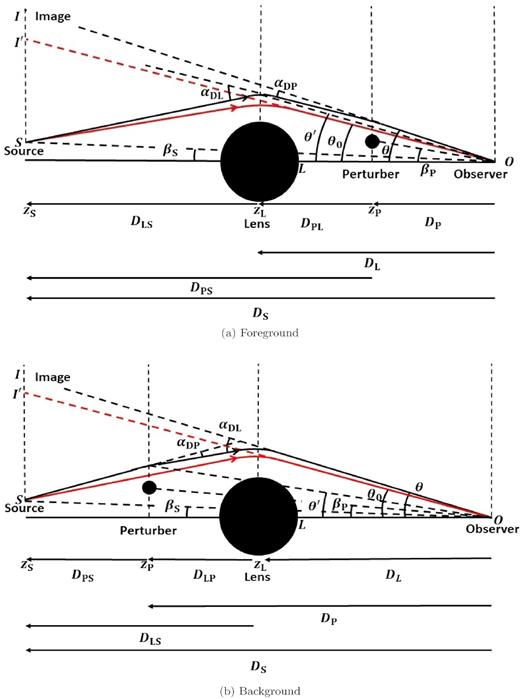
Schematic of the foreground and background double lensing configurations as viewed from the side. The black and red rays denote the perturbed and unperturbed geodesics, respectively. Only one component of the angles is shown.
2.1 Foreground configuration
2.2 Background configuration
2.3 Matrix notation
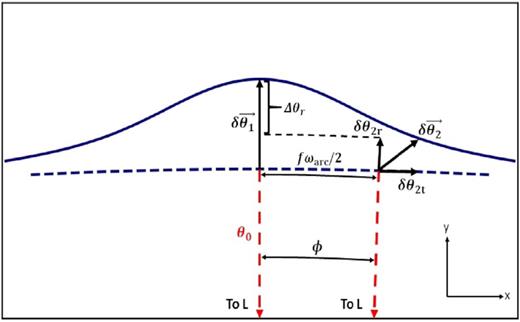
Illustration of the various angles and angular perturbations involved in double lensing. The dashed and solid lines indicate the unperturbed and perturbed arcs, respectively. We consider the perturbation ‘detectable by eye’, if the difference Δθr ≡ δθ1r − δθ2r is sufficiently large compared to the spatial resolution of the observation (see Section 3 for details). Here, the subscript ‘1’ refers to the point along the arc closest to the black hole, while subscript ‘2’ refers to a point that is offset by an angle fωarc/2 along the arc, subtended from the observer. From the centre of the lens, points 1 and 2 subtend an angle |$\phi = \left(f \, \omega _{\rm arc}\right) / (2 \, |\vec{\theta _0}|)$|.
2.4 Lens models
For simplicity, we assume that the source is extended but small enough that the thickness of the observed arc (or Einstein ring) mainly arises from broadening of the data due to the finite resolution of the observation. We also assume that the thickness is uniform along the arc. This effectively implies that we assume uniform sensitivity for detecting perturbers along the entire arc. In general, a single source-lens system can produce multiple arcs whenever the lens is not perfectly aligned with the source. If this is the case, we consider each arc as independent, having its own length and width. At the end of Section 4, we briefly mention how to combine the constraints from multiple arcs.
2.5 Fiducial lensing configuration
Throughout this paper, we consider a fiducial lensing configuration in which the razor-thin arc arises from a source at redshift |$z$|S = 2.056 that is being lensed by an isothermal sphere halo of mass ML(θE) = 1012 M⊙ at a redshift |$z$|L = 0.881. We assume that the arc has a total length of |$\omega _{\rm arc}= 270\,$|mas, and has been observed with a spatial resolution of |${\cal R}= 0.8\,$|mas. Here, and throughout, |${\cal R}$| is defined as the full width half-maximum (FWHM) of the point spread function, in the case of an optical image, or of the (synthesized) beam in the case of interferometric data. These numbers are motivated by an existing observation of a razor-thin arc imaged in the radio with VLBI for the gravitational lens JVAS B1938+666 (McKean et al., in preparation). This spatial resolution is typical for VLBI imaging of gravitational lenses at 1.7 GHz with a global array (e.g. Spingola et al. 2018), although the numbers can change by a factor of a few depending on the actual uv-coverage of the observations, which is a function of the hour-angle and declination of the source.
3 DETECTABILITY OF THE BLACK HOLE
Fig. 3 illustrates how a perturber of mass MP = 107 M⊙, located at |$z$|p = 0.01, impacts our fiducial lensing configuration. The dashed line shows the unperturbed arc, while the three solid lines show the perturbed arc, computed by solving for |$\delta \vec{\theta }$| using equation (12). Different colours correspond to different (angular) impact parameters, as indicated. Note how the distortion becomes more localized (more ‘kink’-like), and more pronounced, as the black hole comes closer to the unperturbed geodesic.

Perturbed arc in presence of a 107 M⊙ perturber at |$z$|P = 0.01 for the fiducial case (|$z$|L = 0.881, |$z$|S = 2.056, ML(θE) = 1012 M⊙, and |$|\vec{\beta _{\rm S}}|=36$| mas, i.e. |$|\vec{\theta _0}| = 1.866\,{\text {arcsec}}$|), obtained by numerically solving the perturbative form of the double lens equation (12). The blue dashed line indicates the unperturbed arc and the coloured solid lines indicate the perturbed arcs for three different angular impact parameters of the perturber (green: 100 mas, red: 50 mas, violet: 30 mas) defined with respect to the unperturbed arc. The black arrows indicate the points on the arc pertaining to the detectability criteria (see equation 22). Note that for each angular impact parameter only one of the two perturbed arcs is shown here.
Throughout this paper, we shall define the ‘detectability’ of the perturber based purely on this geometrical, kink-like distortion, without taking account of how the perturber magnifies or de-magnifies the light along the arc. We focus exclusively on kink-like distortions that are easily detectable ‘by eye’, by which we mean, without any sophisticated analysis. For this to be the case the magnitude of the distortion needs to be both sufficiently large (compared to the resolution of the data), and sufficiently local or ‘kink’-like. The magnitude of the distortion can be quantified in terms of the magnitude of the vector |$\delta \vec{\theta _1}$| in Fig. 2, i.e. the magnitude of the radial distortion at the point closest to the black hole. The importance of the second, ‘locality’ criterion is obvious from considering the green curve in Fig. 3: although in this case |$\vert \delta \vec{\theta _1}\vert$| may be significantly larger than the spatial resolution of the data, |${\cal R}$|, the distortion is not particularly ‘localized’. This owes its origin to the fact that the tangential component of the distortion vector, |$\delta \vec{\theta }$|, can become much larger than the radial component. If that is the case, the distortion may elude detection because it will be difficult to tell such a distortion apart from the effect of external shear, or a small modification of the (shape of) the main lens.
Fig. 4 plots the distortion, Δθr, for our fiducial lensing configuration (Section 2.5) as a function of the angular impact parameter, ΔβP, computed using equations (12) and (17) for a perturber mass of MP = 106 M⊙. The different curves correspond to different redshifts for the perturber (two in the foreground and three in the background), as indicated, while the dashed, horizontal line corresponds to a fiducial spatial resolution of |${\cal R}/2 = 0.4$| mas. Placing the perturbing black hole at a smaller redshift results in a larger distortion, and hence in a wider range of the angular impact parameter for which |$\Delta \theta _{\rm r}\gt {\cal R}/2$|. This is because the Einstein radius of the perturber decreases with increasing redshift.
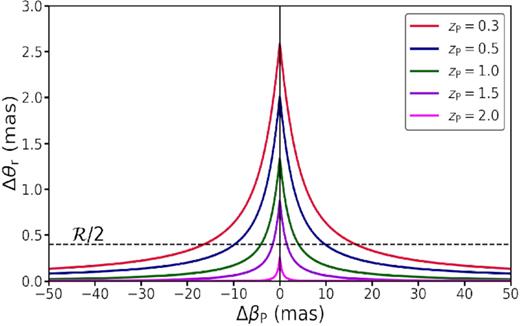
Angular distortion of our fiducial lensing arc, quantified in terms of Δθr as a function of angular impact parameter, ΔβP, for a perturbing black hole of mass MP = 106 M⊙. Results are shown for five different redshifts of the perturber (red and blue in the foreground and the rest in the background), as indicated. The dotted, horizontal line indicates the detection threshold, |${\cal R}/2$|, where we adopt our fiducial, spatial resolution of |${\cal R}= 0.8$| mas. The perturbation is deemed detectable whenever the curve is above this threshold, i.e. when |$\Delta \theta _{\rm r}\gt {\cal R}/2$|). This occurs for a finite range of angular impact parameters, |ΔβP| < ΔβP,max. Note that ΔβP,max decreases with increasing redshift of the perturber and that the maximum distortion (which occurs for zero impact parameter and is equal to the Einstein angle of the perturber) falls below the detection limit beyond a certain redshift.
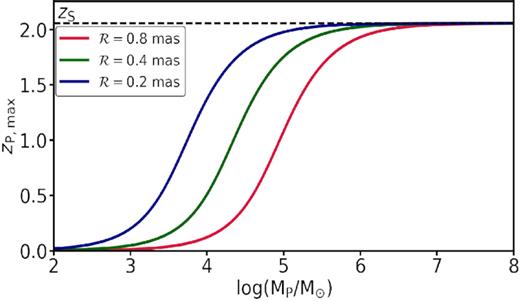
Maximum redshift out to which kink-like distortions of our fiducial arc due to a perturbing black hole are detectable as a function of the black hole mass MP. Different colours correspond to different spatial resolutions, as indicated. The maximum redshift for detectability increases with black hole mass and tends towards the source redshift for sufficiently massive black holes. Also note that it increases for higher spatial resolution.
Fig. 6 plots the maximum impact parameter, |$b_{0,\rm max} = D_{{\rm P}}\Delta \beta _{\rm P, max}$|, as a function of the redshift of the perturbing black hole, |$z$|P, for our fiducial lensing configuration. Different curves correspond to different black hole masses, as indicated. Note how perturbing black holes with mass MP ≲ 107 M⊙ can only be detected out to a redshift |$z$|P, max < |$z$|S (cf. Fig. 5). One can also see from Fig. 6 that |$b_{0,\rm max}$| increases with higher perturber mass.
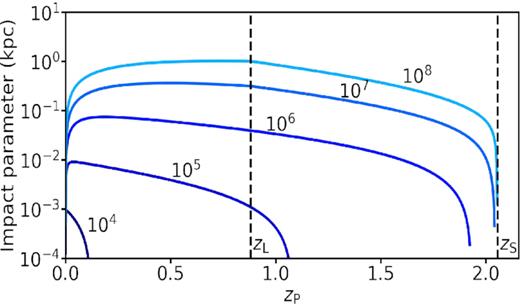
Maximum impact parameter for which a perturbing black hole causes a detectable distortion of our fiducial arc. Results are shown as a function of the redshift of the perturber, |$z$|P, and for five different perturber masses, as indicated. The maximum impact parameter increases with perturber mass but initially increases and then decreases with perturber redshift. Note that the maximum redshift out to which a perturbing black hole can be detected increases with black hole mass, and approaches the source redshift for MP ≳ 107 M⊙.
As already eluded to above, our detectability criterion is based solely on the geometric distortion |$\delta \vec{\theta }$|, without recourse to the magnification caused by the perturber. In order to have an idea as to the potential impact of magnification, we have used GRAVLENS (Keeton 2001) to make mock images of our fiducial razor-thin arc, being perturbed by a black hole of mass MP = 106 M⊙ at a redshift of |$z$|P = 0.5. The resulting images, for a spatial resolution of 0.8 mas, are shown in Fig. 7. From left to right, the different panels correspond to angular impact parameters of ΔβP = −3.2, −1.6, and 0 mas. The left and middle panels reveal local, kink-like distortions similar to what is shown in Fig. 3. In addition, the perturber creates a small, second arclet opposite to the kink, which is a feature that we ignore throughout this paper. When the perturber exactly aligns with the arc, as in the right-hand panel, a small Einstein ring is visible. Upon close inspection of these images, it is evident that the perturber causes some magnification/demagnification of parts of the arc close to the distortion, but overall it is clear that the main characteristic of the distortion is its kink-like geometry, not the corresponding (de)magnification. This justifies the use of our detectability criterion (22). In fact, by focusing only on the geometric distortion, our constraints will be conservative, i.e. a sophisticated analysis of the surface brightness variations along the arc, similar to the analyses of strong-lensing distortions by Vegetti et al. (2014), Hezaveh et al. (2016b), or Birrer et al. (2017), might allow the detection of even lower-mass perturbers due to their localized (de)magnification of the arc.

Mock (noiseless) images constructed using GRAVLENS (Keeton 2001) of the distortions caused in a razor-thin lensing arc due to a perturbing BH of mass MP = 106 M⊙ at |$z$|P = 0.5 along the line of sight. The images have been obtained by boxcar filtering with an FWHM of 0.8 mas. An arc ∼270 mas long is formed due to the gravitational lensing of a source at |$z$|S = 2.056 by a singular isothermal sphere with a mass of ∼1012 M⊙ within the Einstein radius (≈2 arcsec) and located at a redshift |$z$|L = 0.881. The source is assumed to have a Sérsic profile and is aligned at an angle of 36 mas from the baseline. The radius of the unperturbed arc is ≈2.036 arcsec that is equivalent to 2545 pixels (each pixel ≡ 0.8 mas) in this image. The different columns from left to right correspond to different angular impact parameters (ΔβP) of −3.2, −1.6, and 0 mas with respect to the unperturbed arc. Note how the BH causes a kink-like distortion in the arc, which is easily detectable ‘by eye’, given the resolution of the images, and in the absence of noise.
We point out that throughout we assume the main lens to be spherically symmetric. In general, the shape of the kink might change, and the kink itself might be more difficult to identify ‘by eye’, if the main lens is strongly elliptical or if external shear is present. This could potentially make the approach presented here less effective. However, in general such extreme configurations would also disrupt the arc, splitting it in multiple images, and thus leading to a different type of lensing configuration. Hence, given that this is only a fairly crude analysis, based on distortions that are easily identifiable ‘by eye’, and given that only a handful of systems have been observed yet at milliarcsecond resolution, we consider the influence of ellipticity and shear to be higher-order effects that only warrant careful consideration when the quantity and quality of the data improve.
Finally, we emphasize that the localized kink-like distortions considered here must arise from extremely compact objects, such as the black holes. They cannot be caused by perturbations due to the (far more abundant) dark matter haloes along the line of sight. Although dark matter haloes (or subhaloes) can perturb gravitational lensing arcs (see e.g. Koopmans 2005; More et al. 2009; Vegetti & Koopmans 2009; Vegetti et al. 2010, 2012; Hezaveh et al. 2016b; Birrer et al. 2017), we demonstrate in Appendix B that such perturbations are not sufficiently localized to be detectable according to our criterion (22).
4 TOWARDS CONSTRAINTS ON THE COMOVING NUMBER DENSITY OF FREE-FLOATING BLACK HOLES
Our aim in this paper is to translate the presence of kink-like distortions along razor-thin lensing arcs, or the absence thereof, into constraints on the number density of black holes; either primordial ones or wandering black holes that were formed as a by-product of galaxy formation (see Section 1). In the previous two sections, we have shown how to compute the angular extent of such a kink-like distortion, Δθr, for a given lensing configuration and a given black hole mass, and we have shown that the criterion for detectability translates into a constraint on the maximum (angular) impact parameter of the black hole with respect to the unperturbed geodesic from the source to the observer. We now show how a given number of kink-like distortions, Ndis, for a lensing arc of length ωarc, translates into a constraint on the comoving number density of black hole perturbers, nBH. For the sake of simplicity, we ignore potential evolution in nBH with redshift, but that is easily accounted for.
Two-sided confidence intervals (λlower, λupper) for the mean of a Poisson distribution given Ndis detections. We list results for Ndis = 0, 1, …, 5 and for confidence levels of 68 per cent (λ0.160, λ0.840), 95 per cent (λ0.025, λ0.975), and 99 per cent (λ0.005, λ0.995).
| . | λlower . | λupper . | ||||
|---|---|---|---|---|---|---|
| Ndis . | λ0.005 . | λ0.025 . | λ0.160 . | λ0.840 . | λ0.975 . | λ0.995 . |
| 0 | 0.00 | 0.00 | 0.00 | 1.83 | 3.69 | 5.30 |
| 1 | 0.01 | 0.03 | 0.17 | 3.29 | 5.57 | 7.43 |
| 2 | 0.10 | 0.24 | 0.71 | 4.62 | 7.22 | 9.27 |
| 3 | 0.34 | 0.62 | 1.37 | 5.90 | 8.77 | 10.98 |
| 4 | 0.67 | 1.09 | 2.09 | 7.15 | 10.24 | 12.59 |
| 5 | 1.08 | 1.62 | 2.85 | 8.37 | 11.67 | 14.15 |
| . | λlower . | λupper . | ||||
|---|---|---|---|---|---|---|
| Ndis . | λ0.005 . | λ0.025 . | λ0.160 . | λ0.840 . | λ0.975 . | λ0.995 . |
| 0 | 0.00 | 0.00 | 0.00 | 1.83 | 3.69 | 5.30 |
| 1 | 0.01 | 0.03 | 0.17 | 3.29 | 5.57 | 7.43 |
| 2 | 0.10 | 0.24 | 0.71 | 4.62 | 7.22 | 9.27 |
| 3 | 0.34 | 0.62 | 1.37 | 5.90 | 8.77 | 10.98 |
| 4 | 0.67 | 1.09 | 2.09 | 7.15 | 10.24 | 12.59 |
| 5 | 1.08 | 1.62 | 2.85 | 8.37 | 11.67 | 14.15 |
Two-sided confidence intervals (λlower, λupper) for the mean of a Poisson distribution given Ndis detections. We list results for Ndis = 0, 1, …, 5 and for confidence levels of 68 per cent (λ0.160, λ0.840), 95 per cent (λ0.025, λ0.975), and 99 per cent (λ0.005, λ0.995).
| . | λlower . | λupper . | ||||
|---|---|---|---|---|---|---|
| Ndis . | λ0.005 . | λ0.025 . | λ0.160 . | λ0.840 . | λ0.975 . | λ0.995 . |
| 0 | 0.00 | 0.00 | 0.00 | 1.83 | 3.69 | 5.30 |
| 1 | 0.01 | 0.03 | 0.17 | 3.29 | 5.57 | 7.43 |
| 2 | 0.10 | 0.24 | 0.71 | 4.62 | 7.22 | 9.27 |
| 3 | 0.34 | 0.62 | 1.37 | 5.90 | 8.77 | 10.98 |
| 4 | 0.67 | 1.09 | 2.09 | 7.15 | 10.24 | 12.59 |
| 5 | 1.08 | 1.62 | 2.85 | 8.37 | 11.67 | 14.15 |
| . | λlower . | λupper . | ||||
|---|---|---|---|---|---|---|
| Ndis . | λ0.005 . | λ0.025 . | λ0.160 . | λ0.840 . | λ0.975 . | λ0.995 . |
| 0 | 0.00 | 0.00 | 0.00 | 1.83 | 3.69 | 5.30 |
| 1 | 0.01 | 0.03 | 0.17 | 3.29 | 5.57 | 7.43 |
| 2 | 0.10 | 0.24 | 0.71 | 4.62 | 7.22 | 9.27 |
| 3 | 0.34 | 0.62 | 1.37 | 5.90 | 8.77 | 10.98 |
| 4 | 0.67 | 1.09 | 2.09 | 7.15 | 10.24 | 12.59 |
| 5 | 1.08 | 1.62 | 2.85 | 8.37 | 11.67 | 14.15 |
The above applies to the constraints that result from a single arc. When multiple arcs have been observed, the constraint on nBH(MBH) simply follows from adding the effective volumes and distortions of the individual arcs, that is, from using equations (25)–(29) with |$V_{\rm eff} \rightarrow V_{\rm eff, tot} = \sum _{i=1}^{N_{\rm arc}} V_{{\rm eff},i}$| and |$N_{\rm dis}\rightarrow N_{\rm dis,tot} = \sum _{i=1}^{N_{\rm arc}} N_{{\rm dis},i}$|.
5 RESULTS
In this section, we discuss various constraints on the number and mass densities of free-floating black holes that one may realistically achieve with observations of our fiducial razor-thin arc.
5.1 Constraints for single-mass species
We start by considering the case in which all free-floating black holes have the same mass, MBH. Under the assumption of no detected distortions (i.e. Ndis = 0), we obtain an upper limit on the mass density of such black holes, nBH, which we express in terms of ΩBH/ΩDM,0. Here, ΩDM,0 is the assumed dark matter density in units of the critical density, for which we adopt ΩDM,0 = 0.259 (Planck Collaboration XVI 2014), and |$\Omega _{\rm BH} = M_{\rm BH}\, n_{\rm BH}/ \rho _{\rm crit}$|.
The solid lines in Fig. 8 show the constraints on ΩBH/ΩDM that we obtain as a function of the black hole mass MP for different resolutions (left-hand panel), different source redshifts (middle panel), and different values of the parameter f (right-hand panel). In each panel, the red curve corresponds to our fiducial configuration. The constraints on ΩBH/ΩDM are most stringent for intermediate black hole mass with MP ∼ 106 M⊙. The constraints improve with higher spatial resolution (i.e. smaller |${\cal R}$|), especially at the low-mass end, with increasing source redshift, |$z$|S, and depend only weakly on the parameter f that regulates the angular distance along the arc at which we compare the angular distortion, δθr. The trend with |$z$|S is easy to understand from the fact that the effective volume increases with increasing |$z$|S. Similarly, decreasing |${\cal R}$| and increasing f make our detectability criterion (22) less strict, thereby resulting in a stronger constraint on ΩBH/ΩDM. Note that the constraints on ΩBH/ΩDM get tighter with increase in the arc length probed, ωarc, i.e. as more razor-thin arcs are observed.
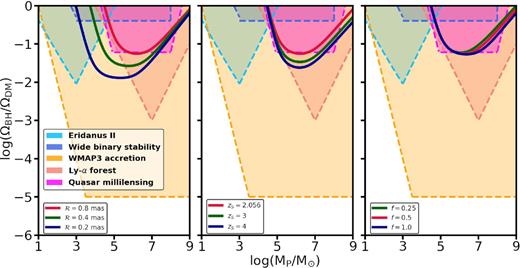
Single null detection: maximum constraint on the ratio of the mean comoving mass density of free-floating black holes (considered as PBHs) to the dark matter comoving density expressed as ΩBH/ΩDM versus black hole mass MP in units of M⊙ for different values of |${\cal R}$|, |$z$|S, and f (ML = 1012 M⊙, ωarc = 270 mas, |$z$|L = 0.881) at |$95{{\ \rm per\ cent}}$| confidence level. The constraints in general are the tightest at some intermediate black hole mass the value of which depends on the spatial resolution |${\cal R}$| with which the arc is probed. Also shown are the previously obtained constraints (shaded regions are ruled out) on ΩBH/ΩDM for PBHs. From the left panel, it can be seen that the constraints get tighter and the characteristic black hole mass (turnover mass) gets reduced for higher spatial resolution. In the near future, with the discovery of more finely resolved lensing arcs, it will be possible to put constraints on the unconstrained regions of the plot, i.e. in the mass range MP ≲ 103 M⊙. Also shown are existing constraints from quasar milli-lensing (Wilkinson et al. 2001), the survival of a star cluster in Eridanus II (Brandt 2016), wide binary stability (Quinn & Smith 2009), the impact of Poisson noise in the matter power spectrum on the Ly α forest (Afshordi, McDonald & Spergel 2003), and WMAP3 constraints on accretion on to black holes prior to recombination (Ricotti et al. 2008).
It is informative to compare these constraints from a null-detection along our fiducial arc to existing constraints. The shaded regions in Fig. 8 show such constraints3 from quasar milli-lensing (Wilkinson et al. 2001), the survival of a star cluster in Eridanus II (Brandt 2016), wide binary stability against tidal disruption by black holes (Quinn & Smith 2009), generation of large-scale structure through Poisson fluctuations and its imprint on Ly α clouds (Afshordi et al. 2003), and WMAP constraints on the accretion effects of PBHs on the CMB (Ricotti et al. 2008). The WMAP and Ly α constraints apply exclusively to PBHs, whereas the other constraints from milli-lensing and dynamical effects apply to all black holes independent of their formation epoch.
Clearly, the constraints from a potential null-detection along our fiducial razor-thin arc are not particularly competitive. For the fiducial redshifts of the source and the lens, and for a fiducial resolution of |${\cal R}=0.8$| mas, the constraints are comparable to those from the quasar milli-lensing constraints of Wilkinson et al. (2001), which derive from the absence of multiple images (at mas resolution) among a sample of 300 compact radio sources. These constraints, though, are much weaker than the constraints (on PBHs) that derive from WMAP or Ly α data. In order for distortions of razor-thin arcs to yield constraints that are competitive with these data we require a sample of hundreds to thousands of razor-thin arcs, preferentially at high spatial resolution, and with high-redshift sources.
5.2 Constraining the mass function of wandering black holes
To demonstrate that the Schechter function is adequate, Fig. 9 plots the mass function of wandering black holes in the Romulus25 simulation (solid dots). The dashed line is the best-fitting Schechter mass function with |$M^*_{\rm BH}= 10^9 \:{\rm M_{\odot }}$|, which accurately fits that data. The resulting best-fitting slope and normalization are α = −2.22 and |$n^*_{\rm BH} = 3.11 \times 10^{-5} \:{\rm Mpc}^{-3}$|. Note that the slope is steeper than −2, which implies that the mass density of wandering black holes in the Romulus25 simulation is dominated by the least massive ones. However, Romulus25 adopts a black hole seed mass of 106 M⊙, and the results shown in Fig. 9 are likely affected by this choice. We therefore caution that the predicted slope is likely to change with a simulation of higher mass resolution and/or lower black hole seed mass.
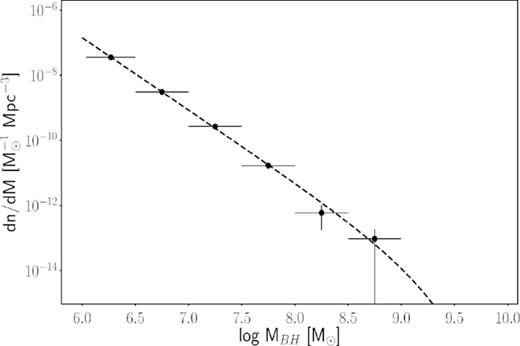
Mass function of wandering black holes (MBH ≳ 106 M⊙) computed from the cosmological simulation Romulus25 and the best-fitting Schechter function with |$M^*_{\rm BH}=10^9 \:{\rm M_{\odot }}$| and the best-fitting values of |$n^*_{\rm BH}=3.11\times 10^{-5}~{\rm Mpc}^{-3}$| and α = −2.22.
Using these expressions, we can transform the confidence interval (λlower, λupper) corresponding to a given number of detected distortions, Ndis, into corresponding constraints on |$n^*_{\rm {BH}}$| and α. In particular, for a null-detection, we have that λdis < 1.83 and 5.30 at 68 and 99 per cent confidence levels, respectively. Using equation (36), these constraints can then be transformed into constraints on ΩBH/ΩDM. Fig. 10 shows such constraints for a null-detection along our fiducial arc when observed with |${\cal R}= 0.8$| mas. The shaded regions mark the 68 and 99 per cent confidence regions and indicate that such a null-detection allows one to rule out |$n^*_{\rm BH} \gtrsim 1~\:{\rm Mpc}^{-3}$| for α ≃ −2. For a significantly steeper mass function, that is, smaller values of α, the constraining power with respect to |$n^*_{\rm BH}$| rapidly diminishes. The thick, solid lines correspond to constant values of ΩBH/ΩDM of 1, 0.01, and 0.0001, as indicated.
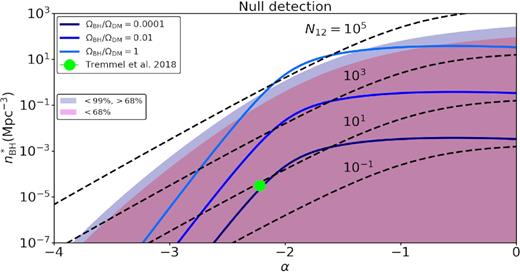
Single null detection: contours of |$n^*_{\rm BH}$| versus α for different values of the occupation number N12 for wandering black holes (dashed lines) and for different values of ΩBH/ΩDM (solid lines). The shaded region represents the allowed values of |$n^*_{\rm BH}-\alpha$| for a null detection of lensing distortion events, given the fiducial configuration (|$z$|S = 2.056, |$z$|L = 0.881, |${\cal R}=0.8$| mas, ML(θE) = 1012 M⊙). The two different shades from top to bottom indicate the 99 and 68 per cent confidence levels. The green dot represents the values of |$n^*_{\rm BH}$| and α obtained by Tremmel et al. (2018b) in their cosmological simulation Romulus25.
As is evident, a null-detection along our fiducial curve basically rules out that the majority of dark matter is in the form of black holes characterized by a Schechter-like mass function. The green dot marks the values of α and |$n^*_{\rm BH}$| for the mass function of wandering black holes in the Romulus25 simulation (cf. Fig. 9). Note that this estimate is based on the assumption that all SMBHs in Romulus25 not located at a galactic nucleus are detectable as free-floating black holes. However, roughly 40 per cent of them reside within 10 kpc from the central galaxy in the halo in which they orbit. For sufficiently close separations (in projection), it may not be possible, or at least be much harder, to detect the wandering black hole, as the (central) galaxy may dominate the gravitational deflection. We have not attempted to account for this, and therefore caution the reader that the Romulus25 prediction shown is likely to be somewhat too optimistic. But even in that case, it is clear that being able to rule-out such a prediction requires data that represents an improvement of several orders of magnitude compared to what is achievable with our single, fiducial arc.

Probability of non-zero detection of wandering black holes of mass ranging from 102 M⊙ to 1010 M⊙ from the distortions of a strong gravitational lensing arc of the fiducial lens system as a function of α for different values of |$n^*_{\rm BH}$|. The black dot represents the probability of a non-zero detection corresponding to the wandering SMBH occupation number in a Milky Way sized halo and α obtained by Tremmel et al. (2018b) in their cosmological simulation Romulus25.
However, as shown in Section 5.1 above, being able to observe at a higher spatial resolution, and finding razor-thin arcs at higher redshifts, may bring this number down considerably. As the number of high-resolution, razor-thin lensing arcs continues to increase, so will our ability to improve on these constraints; it remains to be seen whether enough statistics can be accumulated for this test to become meaningful. Future radio surveys with the Square Kilometre Array (SKA) are projected to detect of order 105 gravitational lensed active galactic nucleus in the radio (McKean et al. 2015). Such sample sizes, coupled with a VLBI capability for the SKA, would turn the method discussed in this paper into an extremely competitive probe of the mass function of free-floating black holes.
6 CONCLUSION
Razor-thin lensing arcs, with sub-mas width, are ideal probes of the coarseness of the matter distribution along the line of sight towards the source that is being lensed. The thinness of the arcs implies a high sensitivity to detecting lensing distortions due to relatively low-mass objects. In particular, the presence of a free-floating black hole at a sufficiently small impact parameter along the line of sight will cause kink-like distortions in the arc (see Fig. 7) that will be detectable if the black hole is sufficiently massive. Here, free-floating black holes are defined as relatively massive black holes (MBH ≳ 102 M⊙) that are sufficiently separated from any galaxy such that they may be considered as isolated for the purpose of computing the lensing distortions on the razor-thin arcs. They basically fall in two categories: PBHs, that form at early times during the radiation dominated era, and wandering black holes that arise as a consequence of the formation and evolution of SMBHs in galactic nuclei.
In this paper, we have investigated the constraints on the number density of free-floating black holes that one may expect to achieve from observations of kink-like distortions of razor-thin arcs, or a lack thereof. Using the double-lens equation, we compute the extent of these kink-like distortions, which we deem detectable ‘by eye’ (i.e. without any complicated lens modelling of the arc surface brightness distribution) as long as the difference in the perturbations along the radial direction, measured at two different positions along the arc, is larger than half the FWHM of the observation. At a resolution of |${\cal R}\sim 0.8$| mas, which is relatively straightforward to achieve with current VLBI facilities at cm-wavelengths, the minimum mass of a perturbing black hole that is detectable is roughly 103 M⊙.
We have computed the constraints on the mass and number density of free-floating black holes that are achievable with a fiducial razor-thin arc of length ωarc ∼ 270 mas and an unresolved width equal to the resolution |${\cal R}\sim 0.8$| mas. For our fiducial arc, we assume that the source is located at a redshift |$z$|S = 2.056, while the main lens is at |$z$|L = 0.881. These values are comparable to those of a razor-thin arc observed from the gravitational lens JVAS B1938+666 with global VLBI at 1.7 GHz (McKean et al. in preparation). If no kink-like distortions are found along such a fiducial arc, one infers that the matter density of free-floating black holes is |$\Omega _{\rm BH} \lt 0.056 \, \Omega _{\rm DM}$| for MBH ≈ 106 M⊙. This is similar to the existing constraint from quasar milli-lensing (Wilkinson et al. 2001). The constraints will improve with increasing total arc length (i.e. more arcs), with increasing source redshift, and, above all, with improved resolution, |${\cal R}$|. In fact, the constraint on ΩBH/ΩDM scales with |${\cal R}^5$| for black holes with a mass below the characteristic mass |$M_0 \simeq 3 \times 10^4 \:{\rm M_{\odot }}\, ({\cal R}/{\rm mas})^2 \, (D_{{\rm S}}/{\rm Gpc})$|. For black holes with MBH ≫ M0, the constraints have a weak dependence on |${\cal R}$|. A null-detection along our fiducial arc, but with a resolution of |${\cal R}= 0.2$| mas, which might be achievable in the near future through observations at a higher frequency, would imply |$\Omega _{\rm BH} \lt 0.013\, \Omega _{\rm DM}$| for MBH ≈ 105 M⊙.
To put these constraints in perspective, we have examined the demographics of wandering black holes in the state-of-the-art hydrodynamical simulation Romulus25 (Tremmel et al. 2018b), which predicts of order 10 wandering black holes with mass MBH > 106 M⊙ per Milky-Way-like halo. The mass function is well fit by a Schechter function with slope α ∼ −2.2 and characteristic cut-off mass |$M^*_{\rm BH} \sim 10^9~\:{\rm M_{\odot }}$|. If we assume that the occupation number of wandering black holes scales linearly with halo mass, the implied mass density of wandering black holes with mass MBH > 103 M⊙ is of order |$\Omega _{\rm BH} = 10^{-4}\, \Omega _{\rm DM}$|. This is more than three orders of magnitude lower than the constraints achievable with our fiducial arc. Put differently, if the predictions of Romulus25 are correct, and there is no additional contribution from PBHs, then the probability of detecting a kink-like distortion due to a free-floating black hole along our fiducial arc is only ∼10−3.
Hence, we are left to conclude that razor-thin arcs, observed at sub-mas resolution, can only provide competitive constraints on the mass density of free-floating black holes if the astronomical community is able to amass a large sample of razor-thin arcs, preferentially associated with sources at high redshift, and observed with the highest-possible spatial resolution. On a positive note, it is important to point out that we have only considered kink-like distortions that are detectable ‘by eye’. When using sophisticated image analysis techniques, similar to what has been used for a number of existing lenses at optical and mm-wavelengths (e.g. Vegetti et al. 2010, 2012, 2014; Hezaveh et al. 2016b), we expect that one ought to be able to improve sensitivity by at least an order of magnitude, resulting in a similar order of magnitude improvement in the constraints on ΩBH/ΩDM. Hence, we remain optimistic that razor-thin arcs will prove to be a powerful probe of the coarseness of the matter distribution on cosmological scales, and of the mass density of free-floating black holes in particular.
ACKNOWLEDGEMENTS
We are grateful to Dhruba Dutta Chowdhury, Johannes Lange, Tim Miller, and Nir Mandelker for help and useful discussions, and to the anonymous referee for valuable comments and suggestions. FvdB is supported by the National Aeronautics and Space Administration under grant no. 17-ATP17-0028 issued through the Astrophysics Theory Program and by the US National Science Foundation through grant AST 1516962 and receives additional support from the Klaus Tschira foundation. FvdB, AM, and SM are grateful to the Kavli Institute for Theoretical Astrophysics at University of California Santa Barbara for support that promoted some of the early discussions regarding this research. SM was supported by Japan Society for the Promotion of Science Kakenhi grant no. 16H01089. This work was supported by World Premier International Research Center Initiative (WPI Initiative), MEXT, Japan.
Footnotes
In the case of interferometric data, this is best done in the UV plane.
To numerically solve the perturbative form of the lens equation, we use the scipy (Jones et al. 2001) module fsolve, which is a wrapper around MINPACK’s hybrd and hybrj algorithms. Both find the roots of a system of N non-linear equations with N variables using a modified form of the Powell hybrid method (Powell 1970).
Tremmel et al. (2018b) quote an occupation number of 12.2, but that includes the SMBH in the centre of the central galaxy.
This is typically the case if the arc length, ωarc, is only a fraction of the entire length of the Einstein ring, |$2 \pi |\vec{\theta _0}|$|.
REFERENCES
APPENDIX A: SCALING RELATIONS
The effective volume specified in equation (26) has to be computed numerically, and involves numerically solving the perturbative form of the double lens equation to compute ΔβP,max(|$z$|). In order to provide some insight as to how Veff scales with the mass of the perturber, MP, and the resolution limit, |${\cal R}$|, it is useful to derive some scaling relations by analytically solving the perturbative lens equation under certain extreme conditions.
It can be seen from equation (A7) that the product of the roots, |$(2 \theta ^2_{\rm {EP}}/{\cal R}) \, |\vec{\theta _0}|^2 \, \phi ^2$|, is positive definite, whereas the sum of the roots, i.e. the coefficient of the quadratic term, is equal to zero. This implies that the equation has only one positive real root. As we demonstrate below, this root behaves differently for small and large |$z$|P.
In what follows, we use equations (A7) and (A8) to derive approximate expressions for the effective volume, Veff, given by equation (26) in the limits of low mass (MP ≪ M0) and high mass (MP ≫ M0).
A1 Low mass limit
A2 Large mass limit
APPENDIX B: DISTORTIONS DUE TO NFW HALOES
In this paper, we examine how localized kink-like distortions of gravitational arcs can be used to constrain the number density of free-floating black holes. However, one might envision other objects to cause similar distortions. In particular, in the ΛCDM paradigm one expects a large abundance of dark matter haloes spanning many orders of magnitude in halo mass. These haloes are predicted to have a universal Naverro-Frenk-White (NFW) density profile (Navarro, Frenk & White 1997), and each halo in turn is predicted to have a hierarchy of substructures (e.g. Jiang & van den Bosch 2016). One might worry that such dark matter (sub)haloes along the line of sight cause similar distortions of razor-thin lensing arcs, and thereby ‘confuse’ our interpretation in terms of free-floating black holes. After all, several groups are using distortions of gravitational lenses to probe dark matter (sub)-structure (e.g. Koopmans 2005; More et al. 2009; Vegetti & Koopmans 2009; Vegetti et al. 2010, 2012; Hezaveh et al. 2016b; Birrer et al. 2017). However, because of their wildly different density profiles, the lensing distortions caused by black holes cannot be confused for distortions caused by NFW haloes.
To illustrate this, Fig. B1 compares the distortions due to a black hole of mass MP = 107 M⊙ (upper panel) to those due to an NFW halo of mass Mvir = 1010 M⊙ and with a concentration parameter cvir = 10 (lower panel). These have been computed by numerically solving the perturbative form of the double lens equation (12). In each case, we show the results for three different angular impact parameters, and we also indicate the value of |$2 \Delta \theta _{\rm r}/{\cal R}$|; this ratio needs to be larger than unity for the perturbation to be considered ‘detectable’ according to our criterion (equation 22). In the case of the black hole, the perturbations easily satisfy our detection criterion, for all three values of the angular impact parameter. In the case of the NFW halo, though, |$2 \Delta \theta _{\rm r}/{\cal R}\lt 0.1$| for all cases shown, and these distortions are therefore not ‘detectable’ based on our criterion. The reason is that the distortions are not sufficiently localized. Rather, the arc is merely displaced from its unperturbed location. An NFW perturber causes a maximal displacement of the arc when the impact parameter with respect to the unperturbed arc is approximately equal to the halo’s scale radius. For the halo considered here, the scale radius is rs ≈ 7.5 kpc, which corresponds to an angular impact parameter of ≈3.5 × 104 mas at the redshift of the perturber (here taken to be |$z$|P = 0.01). Note that the NFW perturber has a mass that is 1000 times larger than that of the black hole; if we were to consider an NFW perturber with a mass of 107 M⊙, the ‘displacement’ of the arc would be a factor of 100 smaller, and the maximum value of |$2 \Delta \theta _{\rm r}/{\cal R}$| would be only ∼0.008. Hence, under no circumstance can NFW haloes along the line of sight cause localized, kink-like distortions such as those due to black hole perturbers.
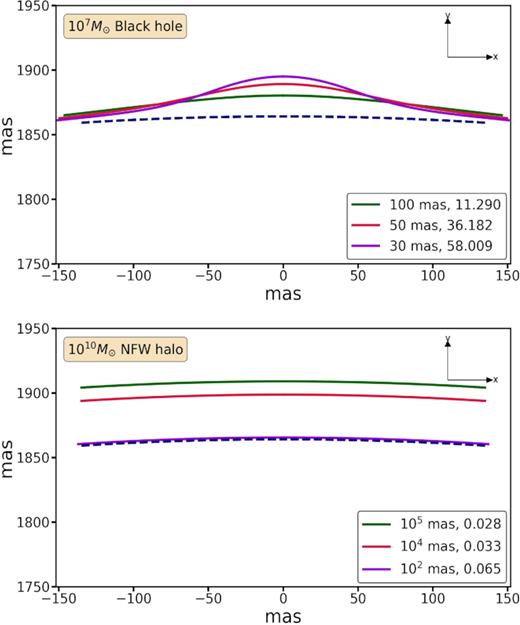
The upper panel shows the perturbed arcs due to a 107 M⊙ black hole at |$z$|P = 0.01 for three different values of the angular impact parameter ΔβP. Here, we consider our fiducial lensing configuration with |$z$|L = 0.881, |$z$|S = 2.056, ML(θE) = 1012 M⊙, and |$|\vec{\beta _{\rm S}}|=36$| mas. The lower panel shows the perturbed arcs in the presence of an NFW halo perturber with Mvir = 1010 M⊙ and cvir = 10. The corresponding values of |$2 \Delta \theta _{\rm r}/{\cal R}$| (assuming the fiducial value of |${\cal R}=0.8$| mas and f = 0.5) are also indicated. If this ratio is larger than unity, the perturbation is deemed detectable according to our criterion (equation 22). As is evident, whereas the black hole perturber is detectable for all three impact parameters shown, the distortions due to the NFW halo are not sufficiently localized to pass our detection criterion.



